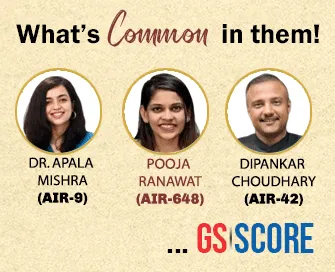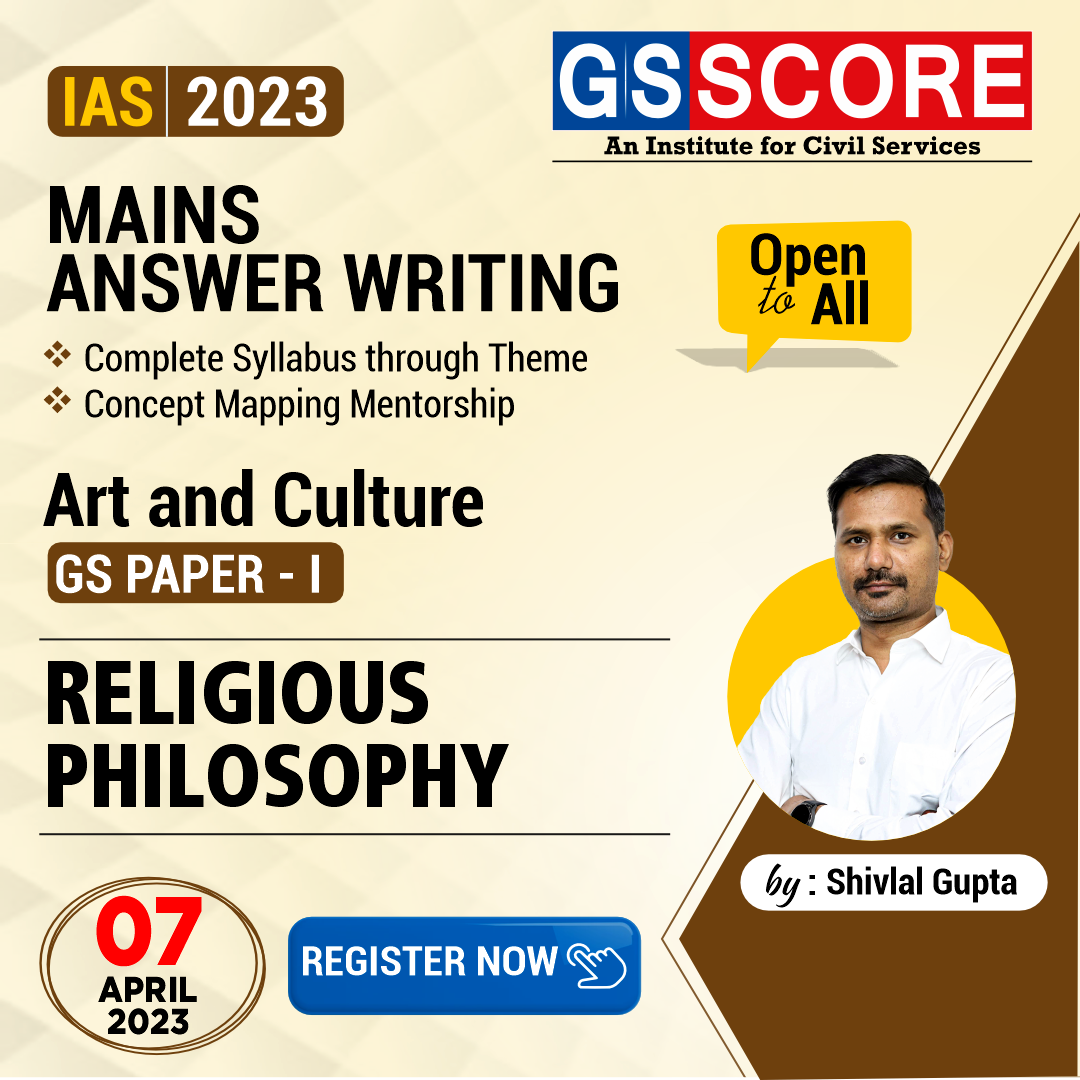


Instruction:
- There will be 2 questions carrying 10 marks each. Write your answers in 150 words
- Any page left blank in the answer-book must be crossed out clearly.
- Evaluated Copy will be re-uploaded on the same thread after 2 days of uploading the copy.
- Discussion of the question and one to one answer improvement session of evaluated copies will be conducted through Google Meet with concerned faculty. You will be informed via mail or SMS for the discussion.
Question #1. Highlight the differences between Saguna and Nirguna Bhakti. Also, explain the contribution of women poets to the Bhakti movement.
Question #2. Bhakti saints of western India, particularly Maharashtra, made significant impact on social and political life of the region and its influence could even be felt in modern times. Elaborate.
(Examiner will pay special attention to the candidate's grasp of his/her material, its relevance to the subject chosen, and to his/ her ability to think constructively and to present his/her ideas concisely, logically and effectively).
STEPS & INSTRUCTIONS for uploading the answers
Step 1 - The Question for the day is provided below these instructions. It will be available at 7:00 AM.
Step 2 - Uploading of Answers : Write the answer in A4 Sheet leaving proper margins for comments and feedback and upload the PDF in MY ACCOUNT section. Click on the option of SUBMIT COPY to upload the PDF.
Step 3 - Deadline for Uploading Answers: The students shall upload their answers by 7:00 PM in the evening same day. The first 50 copies will be evaluated.
Step 4 - Feedback : Mentors will give their feedback for the answers uploaded. For more personalised feedback, join our telegram channel by clicking on the link https://t.me/mains_answer_writing_cse . A one-to-one session will be conducted with the faculty after copy evaluation in 72 Hrs.
Model Answer
Question #1. Highlight the differences between Saguna and Nirguna Bhakti. Also, explain the contribution of women poets to the Bhakti movement.
Approach
- The question focuses on 2 pillars of 1) the similarities and differences of the Bhakti movement in North and south India 2) contribution of the women poets to Bhakti movement.
- Introduction (Summary of key demand of the question, along with necessary facts).
- Conclusion by summing up the gist of the answer.
Hints
The Bhakti Movement stressed on the mystic realization of God within oneself and the ultimate union of the individual with God, based on loving devotion on the part of the devotee (Bhakta). The seeds of the Sanskrit term ‘Bhakti’ can be traced back to both the Brahmanical and Buddhist traditions of ancient India as well as to the various scriptures such as the Vedas, Upanishads and Gita.
Nirguna saguna feature of Bhakti Philosphy
- The Bhakti movement of Hinduism saw two ways of imaging the nature of the divine (Brahman) – Nirguna and Saguna.
- Nirguna Brahman was the concept of the Ultimate Reality as formless, without attributes or quality. Saguna Brahman, in contrast, was envisioned and developed as with form, attributes and quality.
- The two had parallels in the ancient pantheistic unmanifest and theistic manifest traditions, respectively, and traceable to Arjuna-Krishna dialogue in the Bhagavad Gita. It is the same Brahman, but viewed from two perspectives, one from Nirguni knowledge-focus and other from Saguni love-focus, united as Krishna in the Gita.
- Nirguna bhakta's poetry were Jnana-shrayi, or had roots in knowledge. Saguna bhakta's poetry were Prema-shrayi, or with roots in love.
- In Bhakti, the emphasis is reciprocal love and devotion, where the devotee loves God, and God loves the devotee.
The contribution of women poets to Bhakti movement:
- Women Bhaktas wrote of their struggle at home, absent husband, family tensions, restrictions on married life etc. Women also rejected traditional women's roles and societal norms by leaving their husbands and homes and becoming wandering Bhaktas.
- Women wrote beautiful poetry that has been passed on throughout India. Some of them are:
- Akkamahadevi also known as Akka or Mahadevi was a devotee of Shiva in the 12th century CE and was a bhakta from the southern region of Karnataka.
- Her poetry speaks of her frustration with societal norms and the roles that restricted her. They also witness her love for Shiva whom she addressed as Channamallikarjuna.
- Janabai was born in a low caste shudra family in the 13th century. She was sent to work in the upper- caste family of Namdev, one of the most famous bhakti saints. She wrote over 300 poems. All her poems focused on domestic chores and the restrictions she faced as a low- caste woman.
- Mirabai or Mira was born into a ruling Rajput family. Mirabai’s poetry is about her love for Lord Krishna since her childhood and considered herself as his bride. Despite her wishes, she was married into another princely family at a young age yet her love and devotion for Lord Krishna continued. Mirabai left her husband and family and went on a pilgrimage to various places associated with her Lord including
- Brindavan, Krishna’s holy city. Her poetry’s portray her relationship with Krishna in which she is a devoted bride to Krishna and he is ardent in his pursuit of Mira.
- Bahinabai’s writings were mostly autobiographical including her childhood, puberty and married life. Despite the conflicts with her husband over her love for Lord Vithoba, another name for Krishna she took her role as wife and her responsibilities towards her husband seriously.
- SahajoBai -It is generally agreed that she was born in 1683 and died in 1765. In many of her versus she describes the hard work that she goes through grinding corn, carrying water, sweeping and digging. Sahajo’s versus are collected in SahajPrakash, the major text of the Chandradas sect.
Conclusion:
Thus, women poets to Bhakti movement had significant contribution to the society. The Bhakti movement led by both male and female poets led to devotional transformation of medieval Hindu society, wherein Vedic rituals or alternatively ascetic monk-like lifestyle for moksha gave way to individualistic loving relationship with a personally defined god. Salvation which was previously considered attainable only by men of Brahmin, Kshatriya and Vaishya castes became available to everyone.
Question #2. Bhakti saints of western India, particularly Maharashtra, made significant impact on social and political life of the region and its influence could even be felt in modern times. Elaborate.
Approach:
- Briefly describe about the Bhakti movement (50 words)
- Discuss about the movement in western India and give some example of prominent personalities of that time like Meerabai, Surdas, etc. (70 words)
- Highlight the impact of Bhakti saints of Maharashtra in context of modern period ( 80 words)
- Conclusion ( 50 words)
Hints:
Bhakti movement was an important landmark event in the cultural history of medieval India as the silent revolution in society brought about by a number of socio-religious reformers. Bhakti saints emphasized on the mutual intense emotional attachment and love of a devotee towards a personal god and of the god for the devotee.
Bhakti movement in Western India:
- Although the movement probably began in the Tamil region around the 6th and 7th century AD and achieved a great deal of popularity through the poems of the Alvars and Nayanars, it soon began to spread to the rest of country.
- The Vaishnavite Alvars sang praises of Vishnu known as Divya Prabandha as they travelled from one place to another. Similarly the Nayanars worshipped Shiva and influenced Hindu texts that came to be revered all over India.
- Their efforts ultimately helped spread bhakti poetry and ideas throughout India by the 12th–18th century CE, particularly in western and north India.
- Meerabai (1498-1546) from Rajasthan composed and sung devotional verses in praise of Krishna. Meerabai’s intense devotion to Krishna in defiance of patriarchal norms was a rebellious act in medieval era.
- Sundardas was another Bhakti saint from Rajasthan who was also a well known poet, philosopher, social reformer and saint of the medieval India. In his text, Sundarvilasa, he dealt with the six Hindu philosophic systems and suggested ways of attaining salvation.
- Chakradhar Swami, the founder of Mahanubhava Sampradaya of Vaishnavism in 1267, advocated worship of Lord Krishna and preached Dvaita (Dualism) as against non-dualism.
- Dadu Dayal, a Bhakti saint from Gujarat, was a religious reformer who argued against formalism and priestcraft.
Bhakti movement in Maharashtra:
- Maharashtra Bhakti movement is remembered for having long term impacts on the society and becoming a driving force in modern age for social reforms.
- The Bhakti movement did the task of uniting the people of Maharashtra in a common thread of love of man for God. The important figures of the movement were Namdev (1270-1350), Eknath (1533–1599), Tukaram (1608-1650) and Ramdas (1608-1681), among others.
- Namdev opposed idol worship and religious intolerance. He held that salvation could be achieved through Bhakti or devotion to God. His writings were also recognized by the Gurus of Sikhism and are included in the holy book of Sikhism, the Sri Guru Granth Sahib
- Sant Tukaram defying the dictum of the Brahmins chose to write on religious matters and that too in Marathi, the language of the people.
- Bhakti saints in Maharashtra rose up from diverse social backgrounds. Disciple of Namdev, Chokhamela came from untouchable caste and asserted that “I may be from lower caste, but my devotion is not inferior.”
- The idea of Nationalism propagated by the Bhakti saints of Maharashtra and particularly by Ramdasa inspired Maratha king Shivaji to resist Mughal domination and establish a ‘Swarajya’ or self-rule.
- Bhakti saints composed their teachings in Marathi, the language of the masses and helped in refining and developing it along with its widespread popularisation.
- Dnyaneshwar wrote a commentary on Bhagwat Gita in Marathi titled as Bhavartha Dipika for the understanding by common man. This was one of the earliest works of Marathi literature and served as the foundation of Bhakti ideology in Maharashtra.
- The hymns of Tukaram called as ‘Ovis’ were sung by all the classes and they served as a bond of unity among people who belonged to different sections of society.
Influence of Bhakti movement in modern times
- Justice Ranade compared Bhakti movement in Deccan region to the Reformation movement in Medieval Europe and claimed it to be a religious, social and literary revival and reformation in India.
- The impact of Bhakti movement can still be experienced in Maharashtra and surrounding region in modern period with the prevalence of Kirtan, ie, the recitation of preaching of Bhakti saints through storey-telling and singing. The annual pilgrimage to Pandharpur on foot by the ‘Warkari’ sect is also an offshoot of Bhakti devotion.
- By enriching the Marathi language, by providing the rallying points in the form of deities like Vitthal of Pandharpur, by popularizing Kirtana singing and Abhanga (devotional poetry sung in praise of Vitthal) ,the Bhakti saints unified and created sense of belonging for India .
- This led to the rise of Maratha identity which can be seen even in present times. Development of Marathi language and Maratha pride crystallised as a result of Bhakti movement in Maharashtra.
Conclusion:
Thus, the Bhakti movement in western part of India, like the rest of the country, took up the task of purifying religion, educating masses about social justice, breaking away from rigid caste structures and leading to a path of salvation.


